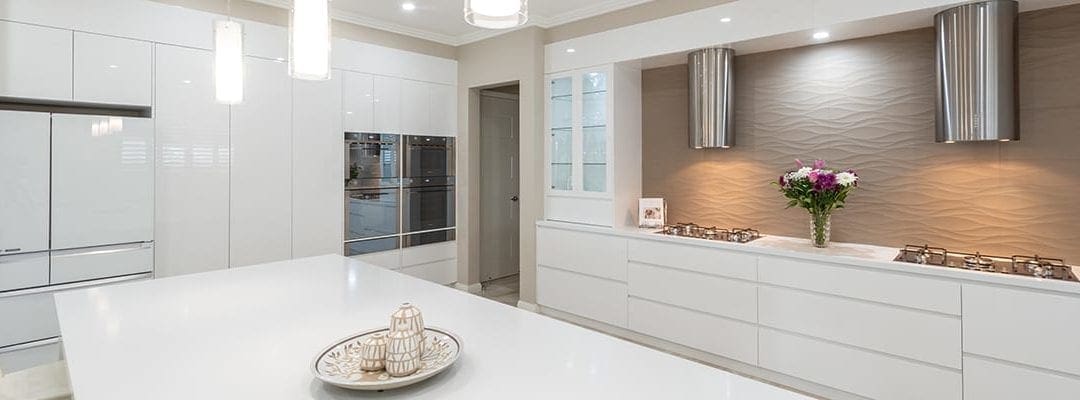Whether it’s your first time or your 10th time, there is no disputing that designing a new kitchen can be extremely exciting and also quite daunting at the same time. There are so many functional elements to plan and design and of course, there are the aesthetic elements to decide on too. No matter what style of kitchen you are dreaming of, there are some core elements to be mindful of when it comes to creating a practical and functional kitchen design.
It doesn’t matter if it is an extravagant and lavish French Provincial style or a minimalist contemporary kitchen, many of the same general kitchen design fundamentals apply in order to ensure that you get the best overall results. In the same vain, getting these kitchen design elements wrong can wreak havoc and really leave a big dampener on what should be a very exciting time spent enjoying your new kitchen.
The best way to avoid falling into the same traps as many that have gone before you is to become aware of what the most common kitchen design mistakes are before you start out on your kitchen design planning journey. Of course, having an experienced and knowledgeable kitchen design team guiding you along the way makes the whole process so much easier to navigate, but it’s certainly worth doing your own homework too.
Here is our pick of common kitchen design mistakes that you should be aware of and what you can do to ensure they don’t pop up in your new kitchen.
Too much open shelving
Open shelving is definitely a great option to vary and break up your storage spaces. It can be very effective for storing and displaying selected kitchen items and when used in combination with cupboards and drawers, provides an interesting visual aspect to your kitchen design.
But as the saying goes, it is possible to have too much of a good thing. You should be mindful to use open shelving sparingly for one of two main purposes. That is to display selected feature items or for storing those things that you want to have readily accessible and close to hand.
If you are going to use some open shelving in your new kitchen design, think carefully about what and where it would be best used, and then leave it at that. It should not be seen, or used, as a complete storage solution for everything that you own!
Too much stainless steel
Having too much stainless steel in your kitchen is something that can happen very quickly and easily without you even realising.
There are many stainless steel appliances, fixtures, and fittings available for kitchens. Whilst these items may all look amazing in isolation, it doesn’t take long to inadvertently accumulate a multitude of stainless steel pieces. Think fridge, oven, dishwasher, and microwave to start and then you could easily end up with a stainless steel sink as well as light fittings and cupboard hardware. Once these items are all installed in close proximity in your kitchen the overall effect can be quite overwhelming and quickly detracts from the other beautiful and careful kitchen design and style choices that you have made. Too much stainless steel can create quite a harsh and sterile look too.
Even if you are creating an industrial style kitchen, where stainless steel can feature quite heavily, it is important to balance it with other materials and textures.
Before you lock in all of your choices, take stock of which and/or how many are stainless steel and consider which items you can swap for alternative finishes or material to not have it become the unwanted focus point of your kitchen.
Not enough power points
Almost everything that we use in a kitchen, and in our lives, these days needs a power point in order to function. From Thermomixers and juicers to iPhones and laptops and a range of things in between, all of which inevitably find themselves in our kitchen spaces at one time or another. You can never have enough power points but you can definitely be left disappointed by not having enough to cater for all that you need to plug in.
As with all kitchen design decisions, think carefully about how you will be using your kitchen and be sure to plan for enough power points to let you effectively do what you need to do.
Don’t forget the rubbish
It’s definitely not the most attractive or exciting part of any kitchen but it is certainly important. Make sure you carefully consider the best placement and solution for your kitchen waste needs.
Having your rubbish and recycling cleverly tucked away in pull-out drawers is a great option. Opting for separate and dedicated bins for rubbish and recycling needs will make things easier to deal with when it comes time to take it all outside, and you’ll be doing your bit for the environment too. At the very least you need to have a designated place for the bins and containers to be concealed. Failing to plan a rubbish and recycling solution for your new kitchen design could mean that you are left with a very unwelcome eyesore in your sparkling new space.
Inadequate lighting/not enough variety
A kitchen should have 3 types of lighting: overhead: for generally lighting the space, spot: for improved lighting in work prep areas, and accent: to do exactly that, highlight focal design features that you want to draw attention to.
Think about how you can incorporate all 3 types of lighting into your kitchen design so that you not only maximise the visual impact of the space that you have worked so hard to create but also so that you have the correct lighting in the right positions when you are hard at work whipping up a culinary masterpiece – or a toasted sandwich and a coffee – whatever takes your fancy.
Playing it safe
You don’t have to go all out on the latest and greatest trends, materials and appliances but that doesn’t mean that your new kitchen design should be boring and sterile either. Inject some much-needed personality and style with carefully chosen décor pieces and accessories such as lighting fixtures and bar stools.
You’ll likely be spending a lot of time in the kitchen so be sure to add some elements that make you feel a little excited and inspired and make your time in there as enjoyable as possible. These items can easily be changed up as the mood strikes you, usually without too much cost or effort.
Think carefully
Perhaps the most important thing when it comes to kitchen design is to not make any rash decisions. Take the time to plan properly and think carefully about each element. This approach will ensure that you have gathered all the information that you need to create an amazing kitchen that best suits your individual needs whilst also avoiding all the mistakes above and more. Most kitchen design mistakes are usually the result of rushed and poor planning.
The team of expert kitchen designers at Harrington Kitchens have many years of experience in designing and delivering custom kitchens to suit the individual and unique needs of each of our clients. Our customer-centric approach ensures that we work closely with you from the very beginning of the planning stages to ensure you get the kitchen of your dreams. Contact our team on 1300 662 112, submit an online enquiry or visit us at our Narellan or Bowral showrooms to discuss your dream kitchen with us today.


Recent Comments